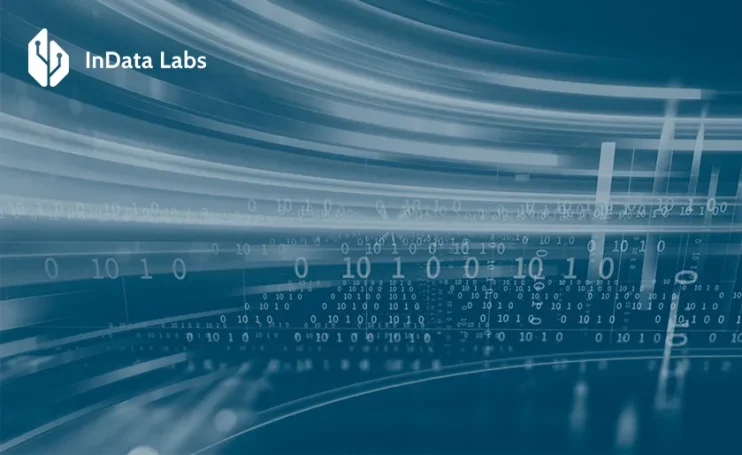Artificial intelligence services have been a hot topic for the last decade. It is hard to find an area or industry nowadays that hasn’t at least tried to use this relatively new tool in its work. However, there is one thing that makes it possible for AI to exist. This thing is DATA. Without high-quality data, any chatbot or facial recognition system is only a bicycle without wheels.
This leads us to our topic today: can AI data collection exist, considering that data is the fuel that nourishes it? Well, can oil and gas be transported by vehicles? The answer to both questions is yes, that is why you are reading this guide on how to use AI for data collection. Let’s dive into the topic without any further delays.

Source: Unsplash
What is artificial intelligence data collection?
The process of AI data collection is more complex than it seems at first glance. The main idea is to accumulate as much high-quality data as possible from various sources. This data is used to educate the AI and provide it with some experience. The more data it has, the “smarter” it is, and the more reliable results it will provide you with.
Data may come from different sources: websites, apps, sensors, people, etc., and there is much of it. The more complicated part of the data collection for AI process is to get it relevant and clean. Good data is like a healthy diet: the more balanced it is, the better results you will get. Thus, our task as AI operators and users is to ensure it gets the best data treats possible.
Types of data for AI
A logical question arises: what data does AI collect? It makes more sense to divide it into several categories and explain what the different types are primarily used for.
- Structured data. It is organized in a clear and comprehensive way (yes, AI also needs a clear representation of information and high-quality data) and resembles accurate tables or Excel files (names, dates, addresses, transactions).
- Unstructured data. With the Big data development, this category has become increasingly numerous. It includes pictures, videos, audio files, and even less structured texts. By less structured, we mean plain text, not formatted into a table or graph.
- Semi-structured data: JSON, XML files, and other similar formats are considered to be semi-structured data and are often used to train chatbots and user interaction systems. This is one of the most critical tasks of AI in data science.
- Time-series data: Weather forecasts, stock prices, cryptocurrency rates, etc., refer to this type of data and is mostly used for predictions, pattern detection, and monitoring.
AI data collection companies often use all types of data to give artificial intelligence as versatile training as possible.
Why data collection is crucial for AI
Modern artificial intelligence and machine learning models are not capable of producing original and unique content. This is not a bad thing, in fact, but at the same time, there is no choice. AI does not have critical thinking; it is only based on the search and analysis of already existing information. That is why AI data collection is crucial for its usage and, more importantly, development. There are several aspects that it influences directly:
- Improves accuracy and guarantees better model performance thanks to better-quality data;
- Makes the AI algorithms smarter and more adaptable;
- Helps to boost and enhance AI development and encourages innovation;
- Ensures that the AI model training process is faster and less demanding.

Source: Unsplash
It is not wrong to say that AI and data collection are tightly intertwined, and the first one cannot exist without the second. To give you a more down-to-earth analogy, artificial intelligence is a fusion cake, and data is flour, without which it would have been impossible to cook it.
How does AI collect data?
AI companies create bots that are machines that require well-structured and clear data. You cannot get well-structured and clear data if you do not clarify and structure the flow of getting it. That is why it is extremely important to plan the whole flow of an AI collecting data properly.
- Define the purpose. Before collecting any information, you must answer a question: why do you want to do that? Why do you need that data? Do you want to teach AI to detect spam e-mails, write essays for school, or produce JS code? It is important to know the goal before you start the process of data collection, otherwise, it will turn into a complete mess.
- Decide on the data sources. Depending on your goal, you need to decide which sources are more relevant to it. You can get data from mobile apps (user interactions), websites (form submissions), APIs (social media), public databases (Kaggle), etc.
- AI collecting data. After you plan everything, it is time to move to the actual collection phase. The main thing you need to understand here is that AI is not a hound; it does not stray around the internet looking for all the data it can consume. Engineers or automated tools do this using various methods:
- Manual entry – all the data is collected and given to the AI manually by people (not really used nowadays, but is still relevant for some narrow areas);
- Web scraping – tracking bots receive the task of collecting information from web pages (prices, reviews, FAQs, etc.).
- APIs – mostly operate for different social media platforms to get structured data in real-time;
- Interaction with users – observations on what users do on the website or what questions they ask to the chatbot.
- Storing the data. AI data collection companies store the collected information in large datasets: databases, warehouses, or lakes (depending on its type) and ensure that it is easily accessible whenever needed.
- Cleaning and processing. All the data acquired before this step is raw, and although it can be used for AI solutions, the effect won’t be impressive. Now, it is time to remove all the duplicates, fix errors, fill missing values, anonymize private info (even AI must be compliant with privacy regulations), etc.
- Labeling (optional). If you want to provide the AI model with some examples, you need to label the data, for instance, what information is spam and what is not (if you want to create an AI spam detector).
- Sharing data with the AI. The most interesting part begins here – feeding all the data gathered and prepared to the AI. The model will process large volumes of information to learn.
- Lifetime support. Allow the AI to collect data even after the initial learning is finished, as it will be used to ensure accuracy, adapt to the novelties, and learn how to handle new problems.
To make it clearer and more applicable, we have prepared a real-life example for you.
Real-life example: E-commerce store
You have an online store, and you want to develop an AI-powered algorithm that will recommend products to customers based on their interests. Here is the general AI data collection flow for such a case.
- Define the goal – gather information about recommended products and offer them.
- Get the information about user purchases, reviews they leave, and what products they view (you can use APIs, tracking pixels, logs).
- Store all the acquired data in the database.
- Clean, preprocess, and label all the data.
- Use it to train the AI.
- Keep track of all the new data to improve the system.
It is important to keep feeding the newly acquired information to the AI so that it can adapt to the changes in user behavior. Using as many data collection methods as possible also helps to reach better results. Watch a video to learn more about advanced data analytics:
AI data collection tools and platforms
All the methods that can be used as AI data collection tools can be divided into several categories that may cover different areas and needs, intersecting in some of them.
- Web scraping tools. Some of the most popular titles are Scrapy and Selenium. They simulate the user’s browsing behavior and collect data that might be produced by real people who are minding their business on the internet. Scapy, for instance, is an open-source online framework that requires you to define the structure of the data you need (text, images, etc.). Then, it crawls the websites, collects the necessary data, and stores it in JSON or CSV format.
- API collection. APIs pull the data from online platforms and services. Tweepy is a good example. It is Twitter’s API that requests the data from the platform in real-time, making it easier to get fresh and up-to-date information from the platform. Most social media platforms have such APIs, accompanied by weather websites and online stores.
- AI tools for data collection. It should not be surprising that AI tools are used to collect data for AI. Scraping, social media monitoring, aggregating tools, chatbots, AI-powered means of collecting data from marketing campaigns, etc. The list of titles can be huge that’s why we won’t overload you with information here, but keep in mind that if you decide to explore the AI data collection process deeper, you might need to explore this market.
Of course, the more tools you can afford to combine, the better. Do not hesitate to use AI for data collection, as it will save you time and increase efficiency in terms of the amount of data you can acquire in a short period.
How to use AI to collect data: some nuances
There are several useful points to remember when you dive into data collection in the AI sphere. They are not crucial enough to be a must-have, but they can simplify work and improve results. First of all, try to collect as much raw data as possible. You will, anyway, preprocess it before feeding it to the AI, so it is better to have some space for the maneuver.

Source: Unsplash
Next, and you may say that it contradicts the first one, prioritize quality over quantity. In fact, nothing is wrong with this recommendation, as we are talking about the preprocessed data. You can gather tons of data in the initial stage, but only use the best to teach the AI, and that is exactly what AI software development companies do.
We have already mentioned why it is important to keep gathering data all the time, so we will skip this one and move to the final point: periodically reviewing the process and data manually to maintain quality. Data collection and AI can operate smoothly, but no one is safe from some random errors and bugs regarding technology. It is better to stay on the safe side and periodically control the quality manually.
Common challenges
Did you expect to have no issues connected to the process? Unfortunately, we have bad news for you. Challenges are everywhere in our lives, and AI is no exception. One of them is AI collecting personal data.
However, it is not a problem itself unless this data gets used to train AI. Personal data cannot be shared with any third-party platform or service, according to the basic privacy regulations, like GDPR or CCPA.
In addition to that, a lot of data is getting missed because of ad blockers, browser restrictions, etc. AI tools, like people, use tracking scripts and algorithms to gather information, and they are often stopped from executing by the things we have just mentioned above. Luckily for us, in a world full of challenges, solutions exist as well.
What can be done
Knowing how AI collects data is not enough to successfully train it. Knowing what challenges await you on this path, it would be logical to understand how to overcome them. There are several options.
- Server-side tracking. Such systems have a lot of ways to bypass blockers and restrictions and process information on the server before sending it to the database. This way, you can ensure that all the events, such as form submissions, purchases, views, etc., are captured and processed forward. Moreover, server-side tracking solves the privacy issue, as all the private data can be encrypted on the server before being sent to the AI database itself. Some companies can help you to answer the question of how to set up server-side tracking and sprinkle it all with some other valuable features and power-ups in change.
- Data augmentation and synthesis. After knowing how to use AI to collect data, it is expected to find out how to use AI to enrich data. This method suggests that new instances can be AI-generated using the data already collected, no matter how full it is. For instance, an image can be flipped, cut, rotated, mirrored, and recombined to get new data points that will be further given to the algorithm. This method is widely used to teach generative AI models.
- Federated learning. This approach might sound new to you as it is hardly used in any other sphere. The idea is that the AI learns directly on the user’s devices and only shares the updates with the main server. A good example is Google’s GBoard, which improves its predictive text model by learning from each particular user’s typing behavior and then shares the results with the server, which later can be used to teach other models.
Again, we are not diving deep into these technologies, as this text is a general overview of AI data collection techniques and nuances.
Should you be particularly interested in any of them, you will have to spend some time learning the details and exploring the services and platforms that offer them. You need to understand the whole machine learning dataset before you start actually “teaching” it.
Conclusion
Do not underestimate the influence of AI models nowadays. It is used in almost every industry, from teaching to programming, and the numbers only keep growing. That is why the question of data collection for AI and its training is so relevant.
Many people think that simply feeding it with any data you can find linked to their industry is the way this training works, and that is not completely true. Feeding the AI in such a way will “reward” you with the results you can hardly call impressive.
Understanding what data is required, how to collect, structure, and preprocess it is essential. We are introducing the main tools and techniques, but there are some nuances. One of the most important questions that arises is how does AI collect personal information, and how to control this process brings us to the point where server-side tracking seems to be almost a must for this sphere.
Data augmentation and federated learning can drastically increase the amount of information that can be used to teach it. A proper combination of everything we have mentioned will reward you with a decent tool in your hands. The main thing is not to stop exploring it, like you do not stop collecting new data to train your AI better.



